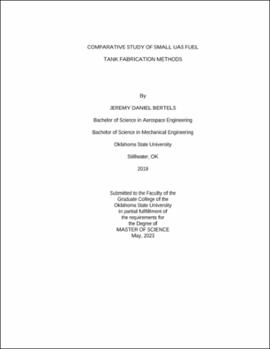| dc.description.abstract | This paper will discuss the development, manufacturing, and testing of various fuel tanks intended for use in small unmanned aircraft with the intent of limiting weight, cost, and manufacturing complexities. The main goals of the research performed is the ability to manufacture multiple variations of fuel tanks in house that will allow for customization of fit and type for varying airframes. Investigated manufacturing methods were determined by the equipment available at the Oklahoma State University aerospace graduate student design lab, which includes composites, 3D printing, and thermoforming. Firstly, research and benchmarking were done to ensure the selected materials would not corrode or degrade over time when exposed to fuel or the operating environment. Selected materials consisted of Kevlar, fiberglass, a fuel safe epoxy, PETG, ASA, and Nylon. After materials were selected three experiments were performed in order to determine the viability of each material and manufacturing method. The first experiment consisted of creating disc samples of each material and pressure testing them in a small pressure pot submerged in water to identify leaks. Small samples were created with varying manufacturing specifications including differing layering for the composite fabrics with different epoxy ratios, multiple different settings for 3D printed parts such as infill density, top and bottom layers, and layer thickness. Both the second and third experiment tested 5.75” spheres that were made with the determined methodology. The second experiment consisted of pressurizing and submerging them in a tank of water to again look for small air leaks to study the effects of scaling up the manufacturing method. Results from the second experiment showed that some changes needed to be made to the composite and 3D printed parts as the increased surface area also resulted in an increase in pin holes, the thermoformed tanks only had small holes around the seam line. For the third experiment the spheres were dropped starting at four inches and increasing by four inches each time if the tank showed no signs of damage or leaks. Drop testing showed that all final manufacturing methods for the tanks are able be made with minimal or no leaks. Finally, with all testing complete and manufacturing methods finalized a cost and weight analysis was performed to compare the experimental tanks to ones available in today's market. | |
